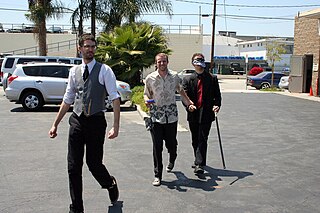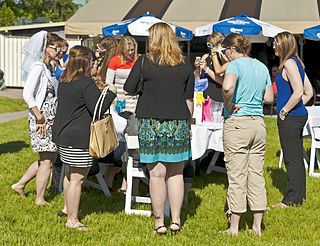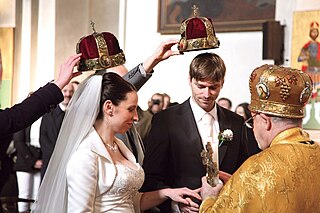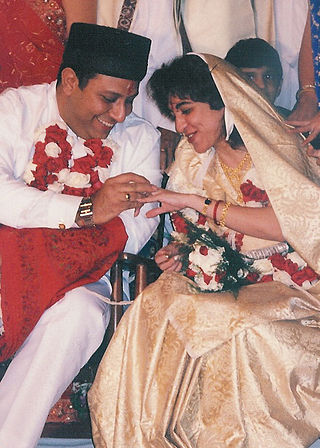
A wedding is a ceremony where two people are united in marriage. Wedding traditions and customs vary greatly between cultures, ethnic groups, races, religions, denominations, countries, social classes, and sexual orientations. Most wedding ceremonies involve an exchange of marriage vows by a couple, presentation of a gift, and a public proclamation of marriage by an authority figure or celebrant. Special wedding garments are often worn, and the ceremony is sometimes followed by a wedding reception. Music, poetry, prayers, or readings from religious texts or literature are also commonly incorporated into the ceremony, as well as superstitious customs.
A white wedding is a traditional formal or semi-formal wedding originating in Great Britain.

A wedding reception is a party usually held after the completion of a marriage ceremony as hospitality for those who have attended the wedding, hence the name reception: the couple receive society, in the form of family and friends, for the first time as a married couple. Hosts provide their choice of food and drink, although a wedding cake is popular.

An engagement or betrothal is the period of time between the declaration of acceptance of a marriage proposal and the marriage itself. During this period, a couple is said to be fiancés, betrothed,intended, affianced, engaged to be married, or simply engaged. Future brides and grooms may be called fiancée (feminine) or fiancé (masculine), the betrothed, a wife-to-be or husband-to-be, respectively. The duration of the courtship varies vastly, and is largely dependent on cultural norms or upon the agreement of the parties involved.

A Little White Wedding Chapel in Las Vegas, Nevada has been the site of many quick celebrity weddings. It is noted for its Drive-Thru Tunnel of Vows. It was established in 1951 or 1955, and has married about 800,000 couples. It employs ten ministers.

A bachelor party, also known as a stag weekend, stag do or stag party, or a buck's night, is a party held/arranged by the man who is shortly to enter marriage.

Quaker weddings are the traditional ceremony of marriage within the Religious Society of Friends. Quaker weddings are conducted in a similar fashion to regular Quaker meetings for worship, primarily in silence and without an officiant or a rigid program of events, and therefore differ greatly from traditional Western weddings. In some respects a Quaker marriage resembles a common-law marriage.

A bachelorette party or hen night is a party held for a woman who will soon be married. While Beth Montemurro concludes that the bachelorette party is modelled after the centuries-old stag night in the US, which is itself historically a dinner given by the bridegroom to his friends shortly before his wedding, Sheila Young argues that its British counterpart evolved from a number of earlier pre-wedding traditions for women whose origins are obscure but which have been around for at least a century in factories and offices across the UK. Despite its reputation as "a sodden farewell to maiden days" or "an evening of debauchery", these events can simply be parties given in honor of the bride-to-be, in the style that is common to that social circle.

The wedding of Prince Charles and Camilla Parker Bowles took place in a civil ceremony at Windsor Guildhall, on 9 April 2005. The ceremony, conducted in the presence of the couple's families, was followed by a Church of England Service of Prayer and Dedication at St George's Chapel. The groom's parents, Queen Elizabeth II and Prince Philip, Duke of Edinburgh, did not attend the civil wedding ceremony, but were present at the Service of Prayer and Dedication and held a reception for the couple in Windsor Castle afterwards.

Traditional Chinese marriage is a ceremonial ritual within Chinese societies that involves not only a union between spouses but also a union between the two families of a man and a woman, sometimes established by pre-arrangement between families. Marriage and family are inextricably linked, which involves the interests of both families. Within Chinese culture, romantic love and monogamy were the norm for most citizens. Around the end of primitive society, traditional Chinese marriage rituals were formed, with deer skin betrothal in the Fuxi era, the appearance of the "meeting hall" during the Xia and Shang dynasties, and then in the Zhou dynasty, a complete set of marriage etiquette gradually formed. The richness of this series of rituals proves the importance the ancients attached to marriage. In addition to the unique nature of the "three letters and six rituals", monogamy, remarriage and divorce in traditional Chinese marriage culture are also distinctive.

Marriage in the Eastern Orthodox Church is a holy mystery (sacrament) in the Eastern Orthodox Church in which a priest officiates a marriage between a man and a woman. The typical Byzantine Rite liturgy for marriage is called the Mystery of Crowning, where the couple is crowned.

Anand Karaj is the Sikh marriage ceremony, meaning "Act towards happiness" or "Act towards happy life", that was introduced by Guru Amar Das. The four laavaan were composed by his successor, Guru Ram Das. Although the recitation of Guru Amar Das' stanzas in Sikh ceremonies is a historical and enduring tradition, the practice of circumabulating around the Guru Granth Sahib to conduct a marriage ceremony is a relatively recent innovation that supplanted the tradition of circumabulating around the sacred fire (havan) in the early twentieth century. The Anand ceremony was originally legalised in India through the passage of the Anand Marriage Act of 1909, but is now governed by the Sikh Reht Maryada that was issued by the Shiromani Gurdwara Prabandhak Committee (SGPC).

Marriage in Korea mirrors many of the practices and expectations of marriages in other societies. Modern practices are a combination of millennia-old traditions and global influences.

The Holy Marriage Blessing Ceremony (축복결혼식), often abbreviated to Blessing, is a large-scale wedding, or a marriage rededication ceremony, sponsored by the Unification Church. It is given to married or engaged couples. Through it, members of the Unification Church believe that the couple is removed from the lineage of sinful humanity and engrafted into God's sinless lineage. As a result, the couple's marital relationship—and any children born after the Blessing—exist free from the consequences of original sin.

A Zoroastrian wedding is a religious ceremony in Zoroastrianism in which two individuals, a man and a woman, are united. In Zoroastrianism, marriage within the community is encouraged, and is greatly favored in religious texts. The following information will detail ceremony procedures and traditional processes for a Zoroastrian wedding.
Las Vegas weddings refers to wedding ceremonies held in Las Vegas, Nevada, which came to be known as the "Marriage Capital of the World" because of the ease of acquiring a marriage license and the minimal costs involved. The city continues to be known as a popular wedding destination for the same reasons, but also as a result of the various types of weddings available.

Traditional Russian weddings can last between two days and one week. The celebration usually involves dancing, singing, toasting, and banqueting. The best man and bridesmaid are called "Witnesses" or "Свидетели" in Russian. The ceremony and the ring exchange take place on the first day of the wedding. Russian weddings ceremonies have undertaken a certain amount of Western traditions, including incorporating maids of honour into the wedding party.

An engagement party, also known as a betrothal party or fort, is a party held to celebrate a couple's recent engagement and to help future wedding guests to get to know one another. Traditionally, the bride's parents host the engagement party, but many modern couples host their own celebration.
In the United States and Canada, weddings follow traditions often based on religion, culture, and social norms. Most wedding traditions in the United States and Canada were assimilated from other, generally European, countries. Marriages in the U.S. and Canada are typically arranged by the participants and ceremonies may either be religious or civil. There is a tradition that the prospective bridegroom ask his future father-in-law for his blessing.
















